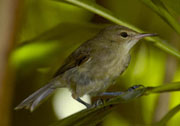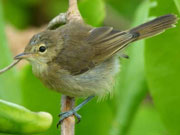Length: 14 cm / 5.5 inches
Wingspan: 17 cm / 6.7 inches
Introduction
For a time, Seychelles Warblers were a critically endangered endemic species, restricted to a small area of native woodland on Cousin. However, a combination of habitat restoration and translocations has now significantly improved the future survival of this precious species. In 2006, there were estimated to be around 300 on Cousin, 200 on Cousine and around 2000 on Aride and numbers are continuing to increase. Furthermore, in 2004, the species was introduced in to Denis.
Identification
Seychelles Warblers are a pale olive green colour, with no distinctive features other than its somewhat varied voice. It is similar in appearance to the Seychelles fody, but slimmer in build, with a longer tail and thinner bill.
Adults are uniformly olive-brown, but with paler under parts, grey-olive bellies and flanks and a pale greyish vent. They have grey-yellow streaks on their breasts and a pale yellow-white throat. They have incomplete buffy-yellow eye stripes and red-brown eyes. Their long, slim bills have an orange base; meanwhile, their long legs are blue-grey. Juveniles are similar in appearance to the adults, but have a considerably shorter tail and slate-grey iris, which turns brown with age.
Voice
Seychelles Warblers have a very considerable repertoire of songs, which includes a harsh sounding "check" alarm call, a repeated "pea-cher, pea-cher", a tuneful "woddle-wee!", a more melodious and failry complex warbling song and a quieter "twee-twee-twee-twee-twee" sub-song. Fledglings are known to emit a rather grating "witch, witch, witch..." when begging.
Behaviour
When hunting for insects amidst the foliage, warblers will make a pronounced clacking sound with their bills. They also catch flies and forage on the ground. They are known to be fairly tame and can sometimes be spotted feeding on open branches and even approaching people.
Pairs will establish a well-defined territory, of which they will occupy all year round. Offspring from previous broods have also been known to help raise the young of their parents.
Breeding
These birds nest throughout the year, although the peak nesting season is between April and June, from the start of the southeast monsoon season. Typically, the female will lay one or two eggs in an open cup nest, concealed within high tree branches.
Praslin - La Digue - Aldabra - Bird Island - Mahe - Islands of the Sainte Anne Marine Park - Desroches & the Amirantes - Silhouette - North Island - Fregate - Cousine - Cousin - Aride - Denis - Alphonse - Felicite - Marianne - Victoria - Assumption - Cosmelido - Vallée de Mai - Coco de Mer - St Pierre - Seychelles Black Parrot - Seychelles Blue Pigeon - Seychelles Fruit Bat - Seychelles Paradise Flycatcher - Scops Owl - Giant Tortoise - Tailor Made Holiday in the Seychelles - Bareboat & Skippered Yacht Charters - Sailing Guide to Seychelles - Liveaboard Diving - Dive & Snorkel Holidays - Wildlife Natural History & Birdwatching - Beaches - beach vacations - Marine Life whales sharks rays dolphins & coral reefs - Hiking Trekking Car Rentals Hotels Resorts & Accommodation - Mountains & Rainforest - Responsible Travel - Honeymoons & weddings - Family Adventures - Single Travellers - Whale Shark Research & Conservation




